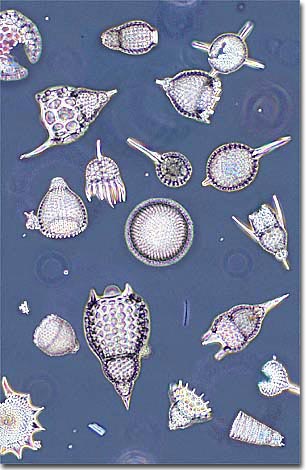Phase Contrast Image Gallery
Radiolarians
A mixed population of unarranged radiolarian skeletons is illustrated in the photomicrograph below. Medium power objectives with phase contrast optics were used with an Olympus inverted tissue culture microscope to obtain the image.

Radiolarians are single-celled protistan marine organisms that distinguish themselves with their unique and intricately detailed glass-like exoskeletons. During their life cycle, radiolarians absorb silica compounds from their aquatic environment and secrete well-defined geometric networks that compose a skeleton commonly known as tests. The radiolarian tests are produced in a wide variety of patterns, but most contain many spines and holes that regulate a network of pseudopods useful in gathering food. Cytoplasm from these microscopic creatures contains numerous vacuoles that fill with air to keep the animals afloat in the upper ocean waters. Radiolarians reproduce asexually, usually by division of the cell (including the exoskeleton), with the remaining daughter cells each regenerating a complete organism. Dead radiolarians accumulate in the ocean floor sediment and are often useful in geological dating experiments.
BACK TO THE PHASE CONTRAST GALLERY
